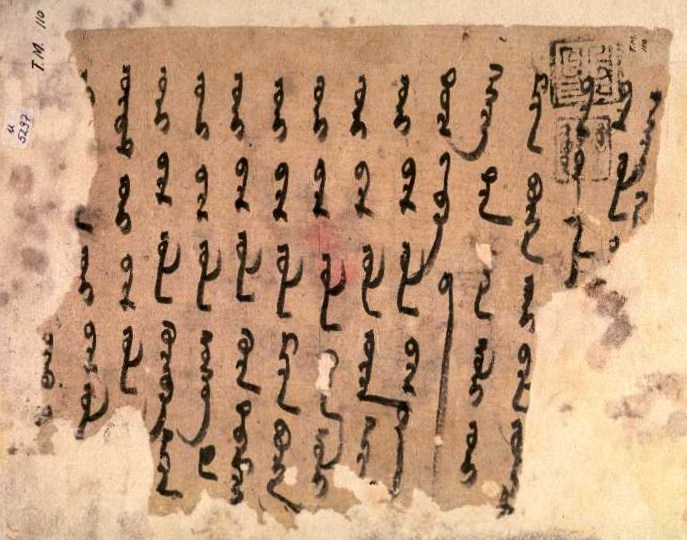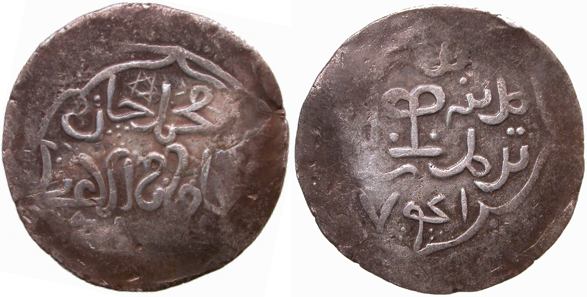BabelStone Blog
Friday, 11 November 2011
Phags-pa Uyghur Seals
In last week's blog post about a Phags-pa Uyghur inscription at Dunhuang, I mentioned that there are very few extant examples of Uyghur written in the Phags-pa script, so this week I thought I'd take a look at some examples of Phags-pa Uyghur seal imprints on 14th century Old Uyghur and Mongolian documents. It turns out that that the place where you can find the largest number of manuscripts with Phags-pa Uyghur seal imprints is the Berlin Turfan-Collection of the Berlin-Brandenburg Academy of Sciences and Humanities. Fifteen Old Uyghur documents and the seal impressions on them are discussed in detail in a 1998 paper by Matsui Dai entitled "Uigur Administrative Orders Bearing 'Qutluγ-seals'". Matsui notes in the abstract that the documents are administrative orders for delivering various objects such as flour, and that "they are issued by a single group of officers and dated to the 14th century when Uiguristan was under the domination of Chaghatai-ulu".
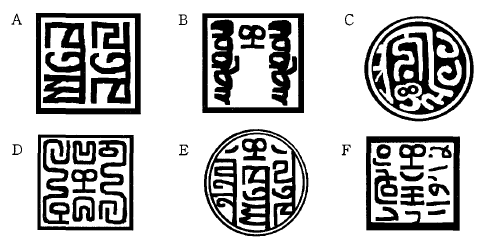
Drawings of six types of seals on Uyghur documents (Matsui 1998 Fig. 1)
The table below lists some examples of seal imprints in Phags-pa (and other scripts for completeness) that I have noticed on Old Uyghur and Mongolian manuscripts in the Berlin Turfan-Collection. Many of the seals are virtually illegible, but some of them, as in the example below, are relatively clear and easy to read.
Uyghur administrative order (U 5297) with a Phags-pa Qutluɣ seal
The top seal in the above document illustrates the most common Phags-pa Uyghur inscription, which is simply the word ꡢꡟꡉ ꡙꡟꡢ quth luq (Old Uyghur qutluɣ), meaning "good luck" or "good fortune" [Matsui Type A]. The Phags-pa word quth luq occurs on at least eleven seals in the table below. In seven examples the word quth luq occurs by itself, but in three examples it is prefixed by the Phags-pa word ꡄꡞꡋ cin (Old Uyghur čïn), meaning "true, sincere" [Matsui Type E]. With a slightly different spelling the same word also occurs on a jade seal with the Old Uyghur inscription ꡅꡞꡋ ꡉꡦꡟ ꡂꡦꡙ chin thėu gėl (Old Uyghur čïn tükäl), meaning "true perfection". Thus, on these seals cin quth luq (Old Uyghur čïn qutluɣ) means "true good fortune" (Matsui translates into Japanese as "真に幸運な). The eleventh qutluɣ seal (MongHT 071) was the first to be noticed, in 1909, on a Mongolian document, and has the longest inscription : ꡡ ꡘꡡꡋ ꡢꡟꡊ ꡙꡟꡢ ꡌꡡꡙ ꡛꡟꡋ o ron qud luq pol sun (orun qutluɣ bolzun) "May there be good fortune [in this] country".
Many of the seals also bear a tamga in the form of an inverted Tibetan letter Cha ( ), which was commonly used on coins issued by several Chaghatayid khans (1226–1388), in particular Duwa (reigned AH 681–706, AD 1282–1307). It is thus known as the "Chaghatayid tamga" or "Duwa tamga".
), which was commonly used on coins issued by several Chaghatayid khans (1226–1388), in particular Duwa (reigned AH 681–706, AD 1282–1307). It is thus known as the "Chaghatayid tamga" or "Duwa tamga".
Zeno 29117 : Chaghatayid, AR dinar, Muhammad Khan (AH 740–741, AD 1339–1340), Tirmidh Madinat al-Rijal AH 741 (AD 1340), with tamga of Duwa on reverse
In addition to the qutluɣ seals, there are several seals with other inscriptions in Phags-pa script. Two seals (U 5316 and U 5323) have a Phags-pa inscription that looks like ꡂꡨꡦꡙ gyėl on the righthand side, and the same text rotated 180° on the lefthand side [Matsui Type D], which perhaps represents Tibetan rgyal རྒྱལ་ "king", with fronting of the a after the gy- (cf. the spelling of buyan as buyėn and qaya as qayė in the Phags-pa inscription at Dunhuang). Another seal (U 5303) has an incomplete inscription ꡌꡦ ... ꡂꡦ ... pė[...] gė[...] which I cannot provide a plausible reading for. One last seal (MongHT 071) has an inscription which I provisionally read as ꡁꡦꡘ ꡏ ꡋꡟ ꡍ ꡁꡦ ꡍꡟ khėr ma nu pha khė phu, but I am unsure how to interpret this, or even what language this is (khėr could be Mongolian "how", and manu could be Mongolian "our", but that does not make a lot of sense).
There is one seal only that has a definite Chinese Phags-pa inscription (U 5312, in Phags-pa seal script and imprinted in red). It is incomplete, but I read it as ꡂꡡꡋ ꡙꡞꡃ ꡟ ꡔꡞꡋ gon l[iŋ] u ži[n], corresponding to Chinese Guǎnlǐng Wú Rén 管領吳仁, where guǎnlǐng 管領 "supervisor" is the title of a Yuan dynasty official who oversees staff in a government agency (Hucker #3318), and Wu Ren is the name of the official.
Seals on Old Uyghur and Mongolian Documents
| Seal | Shelfmark | Phags-pa | Notes |
|---|---|---|---|
 |
U 5284 | Old Uyghur ? plus Chaghatayid tamga  . . |
|
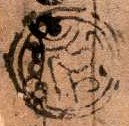 |
oṁ (Sanskrit). | ||
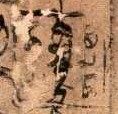 |
Old Uyghur. | ||
 |
U 5285 | Illegible. | |
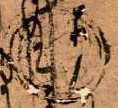 |
Illegible. | ||
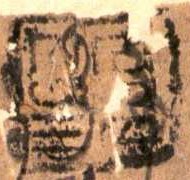 |
U 5288 (1358) | ꡢꡟꡉ ꡙꡟꡢ | Phags-pa quth luq = Old Uyghur qutluɣ "good fortune". |
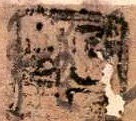 |
U 5291 (1358) | ꡢꡟꡉ ꡙꡟꡢ | Phags-pa quth luq = Old Uyghur qutluɣ "good fortune". |
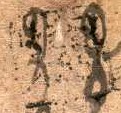 |
U 5292 | Illegible. | |
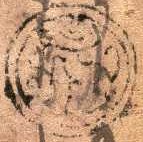 |
oṁ (Sanskrit). | ||
 |
U 5297 | ꡢꡟꡉ ꡙꡟꡢ | Phags-pa quth luq = Old Uyghur qutluɣ "good fortune". |
 |
Old Uyghur qutluɣ "good fortune" twice. | ||
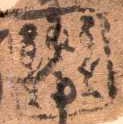 |
U 5300 (1357) | Old Uyghur qutluɣ "good fortune" twice. | |
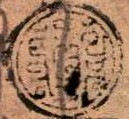 |
ꡄꡞꡋ ꡢꡟꡉ ꡙꡟꡢ | Phags-pa cin quth luq = Old Uyghur čïn qutluɣ "true good fortune" plus Chaghatayid tamga  . . |
|
 |
Old Uyghur ? | ||
 |
U 5303 (1360) | Illegible. | |
 |
Illegible. | ||
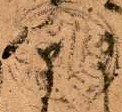 |
Persian ? (Matsui suggests Brāhmī). | ||
 |
ꡄꡞꡋ ꡢꡟꡉ ꡙꡟꡢ | Phags-pa cin quth luq = Old Uyghur čïn qutluɣ "true good fortune". | |
 |
Old Uyghur ? plus Chaghatayid tamga  . . |
||
 |
ꡌꡦ ... ꡂꡦ ... | Phags-pa pė[...] gė[...]. pė- is an unusual spelling, which does not occur in Chinese (this initial/vowel combination is not attested in Měnggǔ Zìyùn), and would not be expected in Mongolian or Uyghur, which do not have an initial p- in native words, although possibly it represents Old Uyghur bä[-] (e.g. bäg "lord"). However, it is also possible that pė- is a mistake for the graphically similar lė- (cf. MongHT 071 where pol sun is miswritten pop sun), although that does not give an obvious reading either. | |
 |
U 5305 | Illegible. | |
 |
Illegible. | ||
 |
Flower design. | ||
 |
Phags-pa ? | ||
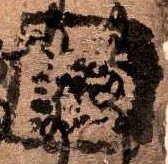 |
U 5308 | Illegible. | |
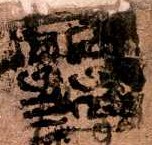 |
U 5309 (1358) | ꡢꡟꡉ ꡙꡟꡢ | Phags-pa quth luq = Old Uyghur qutluɣ "good fortune". |
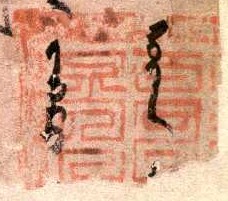 |
U 5312 | ꡂꡡꡋ ꡙꡞꡃ ꡟ ꡔꡞꡋ | Phags-pa gon l[iŋ] u ži[n] = Chinese Guǎnlǐng Wú Rén 管領吳仁 "Supervisor Wu Ren". The Phags-pa letters are written in the seal script style that is normal for Chinese Phags-pa official seals; this is different to the Phags-pa Uyghur seal inscriptions, which use ordinary Phags-pa letters. |
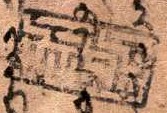 |
U 5315 | Uncertain. | |
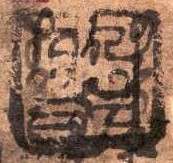 |
U 5316 (1361) | ꡢꡟꡉ ꡙꡟꡢ | Phags-pa quth luq = Old Uyghur qutluɣ "good fortune". |
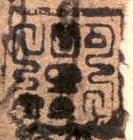 |
ꡂꡨꡦꡙ | Phags-pa gyėl ? = Tibetan rgyal རྒྱལ་ "king" ? on each side with rotational symmetry, plus Chaghatayid tamga  . . |
|
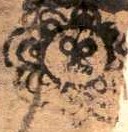 |
Chaghatayid tamga  . . |
||
 |
U 5323 | Illegible. | |
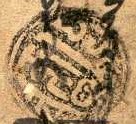 |
Persian ? (Matsui suggests Brāhmī). | ||
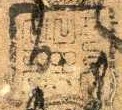 |
ꡂꡨꡦꡙ | Phags-pa gyėl ? = Tibetan rgyal རྒྱལ་ "king" ? on each side with rotational symmetry, plus Chaghatayid tamga  . . |
|
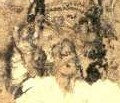 |
Illegible. | ||
 |
U 5324 | Illegible. | |
 |
Illegible. | ||
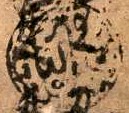 |
Persian ? (Matsui suggests Brāhmī). | ||
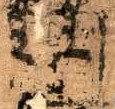 |
Illegible. | ||
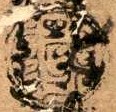 |
ꡄꡞꡋ ꡢꡟꡉ ꡙꡟꡢ | Phags-pa [cin?] quth luq = Old Uyghur čïn qutluɣ "true good fortune" plus Chaghatayid tamga  . . |
|
 |
Old Uyghur qutluɣ "good fortune" ? | ||
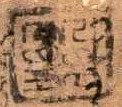 |
U 5325 (1357) | ꡢꡟꡉ ꡙꡟꡢ | Phags-pa quth luq = Old Uyghur qutluɣ "good fortune". |
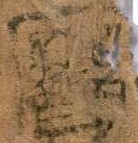 |
U 5967 (1362) | ꡢꡟꡉ ꡙꡟꡢ | Phags-pa quth luq = Old Uyghur qutluɣ "good fortune". |
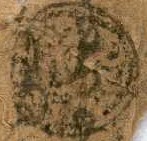 |
Illegible. | ||
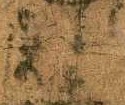 |
Illegible. | ||
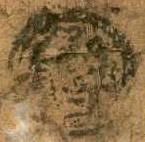 |
Illegible plus Chaghatayid tamga  . . |
||
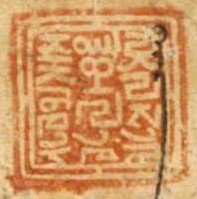 |
MongHT 071 page 1 | ꡡ ꡘꡡꡋ ꡢꡟꡊ ꡙꡟꡢ ꡌꡡꡌ ꡛꡟꡋ | Phags-pa o ron qud luq pop sun (pop is a mistake for the graphically similar pol) = Old Uyghur orun qutluɣ bolzun "May there be good fortune [in this] country". In addition to the miswriting of Phags-pa letter LA (ꡙ) as Phags-pa letter PA (ꡌ), the letters of each syllable are disjointed (not ligatured as required in normal Phags-pa writing), indicating that the inscription was copied by someone who was not very familiar with the Phags-pa script. Orthographically, the final -d for qut where the other seals have -th is unexpected but plausible, and the initial p- for bol is not that unusual (cf. the Phags-pa spelling of pur xan for Mongolian burqan "Buddha"). The formula qutluɣ bolzun "May you have good fortune!" is very common, but I cannot find another example of the expression preceded by oron ~ orun "place, seat, throne, territory, country", which I assume here indicates "[in this] country, may there be good fortune". |
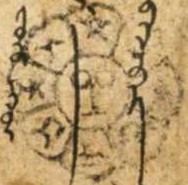 |
Chaghatayid tamga  in centre of an eight-petalled flower with Brāhmī letters (?) or symbols on each petal. in centre of an eight-petalled flower with Brāhmī letters (?) or symbols on each petal. |
||
 |
MongHT 071 page 2 | ꡁꡦꡘ ꡏ ꡋꡟ ꡍ ꡁꡦ ꡍꡟ | Phags-pa khėr ma nu pha khė phu (?) plus Chaghatayid tamga  . The Phags-pa inscription is written sideways, and can be seen at the correct orientation by rotating the seal imprint anticlockwise 90° (click on the image to rotate). . The Phags-pa inscription is written sideways, and can be seen at the correct orientation by rotating the seal imprint anticlockwise 90° (click on the image to rotate). |
 |
Chaghatayid tamga  . . |
||
 |
Illegible. | ||
 |
Chaghatayid tamga  . . |
||
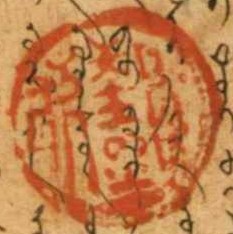 |
MongHT 074 | Unknown writing (Mongolian?) on both sides, plus three tamgas in middle (Chaghatayid tamga at bottom ?). | |
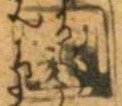 |
Illegible. | ||
 |
MongHT 071 recto | Unknown writing on both sides, plus Chaghatayid tamga  . . |
|
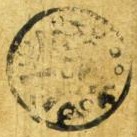 |
MongHT 076 verso | Illegible (Brāhmī ?). | |
 |
Vajra design ? | ||
 |
Uncertain (Brāhmī ?). |
In addition to the above examples, the following manuscripts have, or have been claimed to have, Phags-pa Uyghur seals :
- U 3908 — this manuscript has five small seal imprints on it, one or more of which Zieme 1974 apparently reads as Phags-pa qutluɣ, but in my opinion none of these seals have Phags-pa inscriptions on them, and it is doubtful that they are even writing.
- U 5510 — Matsui states that this document has two Phags-pa seals (his types D and E), but for the life of me I cannot see them anywhere.
- U 5232 — this manuscript has two small seal imprints on it, one of which Zieme 1974 apparently reads as Phags-pa qutluɣ, but in my opinion neither of these seals have Phags-pa inscriptions on them, and it is doubtful that they are even writing.
- K 7719 (中国国家博物馆) — Matsui states this has one seal imprint (his type A), but I have not seen this manuscript.
- Ot. Ry. 8127 (谷大学大宮図書館) — Matsui states this has four seal imprints (his types A, C, D and E), but I have not seen this manuscript.
- Istanbul No. 12 (İstanbul Üniversitesi Merkez Kütüphanesi) — Matsui states this has two seal imprints (his types A and C), but I have not seen this manuscript.
Bibliography
- Matsui Dai (松井太), "Uigur Administrative Orders Bearing 'Qutluγ-seals'"; in Studies on Inner Asian Languages 13 (1998) pages 1–62.
- G. J. Ramstedt, "Mongolische Briefe aus Idiqut-Schähri"; in Sitzungsberichte der Königlich Preussischen Akademie der Wissenschaften zu Berlin (1909) pages 838–848.
- Peter Zieme, "Ein uigurischer Landverkaufsvertrag aus Murtuq"; in Altorientalische Forschungen vol.1 (1974) pages 295–308.
- Peter Zieme, "Turkic Fragments in 'Phags-Pa Script"; in Studies on Inner Asian Languages 13 (1998) pages 63–69.
Last updated : 2014-12-15.
Index of BabelStone Blog Posts
